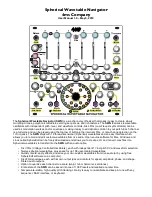
PSY-201 User Guide
GP-UM-PSY-201-11
Page 29 of 105
The waveform graphic indicator appears when modulation is enabled, and indicates the
waveform type for the selected channel. The unit indicator indicates the units for the parameter
that is being set (e.g. Hz for frequency; V,
π
, or Rad for amplitude and offset).
After setting the modulation parameters for one or more channels, press the
■
/
►
button
to enable the modulation. For the modulation function, the
■
/
►
button acts as a pause/resume
button.
Figure 19 Sample modulation patterns.
Pol. Manual Control
This function allows the user to change the output polarization state through direct control
of the control voltages applied to the four channels of the polarization controller. In all of the other
control modes, the user selects a desired polarization state or series of states, and then the PSY-
201 determines and applies the control voltages required to generate the requested state(s). This
direct control mode allows for quick, almost continuous tuning of the polarization state, and is
especially convenient when the output polarization state can be simultaneously monitored using
the PolaView™ display software. As mentioned in the introduction, changing the voltage on
channel 1 causes the polarization state to rotate about a particular axis on the Poincaré sphere,
while changing the voltage on channel 2 will cause it to rotate about an axis orthogonal to that of
channel 1, and so on. By independently tuning the control voltages on the 4 channels of the
polarization controller, the user can change the output polarization to any state on the Poincaré
sphere. Figure 20 shows an example. Point 1 is the initial SOP. From there, the voltages on the 4
channels were sequentially changed in 1-volt steps as follows:
Δ
V1 = 10V
→
pt 2
Δ
V2 = 15V
→
pt 3
Δ
V3 = 20V
→
pt 4
Δ
V4 = 20V
→
pt 5













































